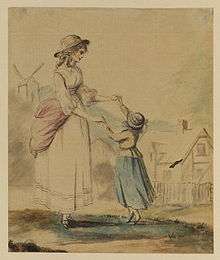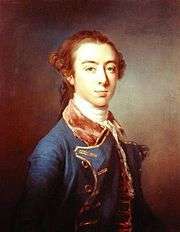Lady Diana Beauclerk

Lady Diana Beauclerk (née Lady Diana Spencer; other married name Diana St John, Viscountess Bolingbroke) (27 March 1734–1 August 1808) was an English noblewoman and artist.
Life and work

She was the daughter of the Honourable Elizabeth Trevor (d. 1761) and Charles Spencer, 3rd Duke of Marlborough (1706–1758). Her siblings were George, Charles, and Elizabeth. She was raised at Langley Park, Buckinghamshire, where she was introduced to art at an early age. Joshua Reynolds, an artist, was a family friend.

She married Frederick St John, 2nd Viscount Bolingbroke (1734–1787) in 1757, and from 1762–1768 was Lady of the Bedchamber to Queen Charlotte. She became widely known as 'Lady Di' (as did her namesake in the early 1980s).

Her marriage was unhappy and Bolingbroke was notoriously unfaithful. In February 1768 he petitioned for divorce on grounds of adultery. The petition required an act of parliament, which was passed the next month. Within two days she married Topham Beauclerk of Old Windsor. They had four children:
- Anne (born ca. 1764, and did not survive infancy)
- Elisabeth Beauclerk (20 August 1766 – 25 March 1793)
- (Anne) Mary Day Beauclerk (29 June or 20 August 1766 – 23 July 1851), twin of Elisabeth. She famously had a long-term relationship with her own half-brother Bolingbroke, and had four sons by him. After he abandoned her, she married 1797 Franz Raugraf Jenison von Walworth (1764–1824), a German count of English parentage, and had legitimate issue 2 sons (one son deceased) and four daughters. (Her descendants via her youngest daughter Emilie or Amalie include princes of Loewenstein-Wertheim-Freudenberg, and through them, other German royalty).
- Charles George Beauclerk (20 January 1774 – 25 December 1846), M.P. for Richmond (1796-8), in 1799 he married Emily Charlotte Ogilvie, daughter of Emily Mary Lennox, Duchess of Leinster, by second husband, William Ogilvie.
Their circle of friends included Samuel Johnson, Georgiana Cavendish — who maintained a glittering salon — Edward Gibbon, David Garrick, Charles Fox, James Boswell and Edmund Burke.
Beauclerk illustrated a number of literary productions, including Horace Walpole's tragedy The Mysterious Mother, the English translation of Gottfried August Bürger's Leonora (1796) and The Fables of John Dryden (1797). After 1785 she was one of a circle of women, along with Emma Crewe and Elizabeth Templetown (1746/7-1823), whose designs for Josiah Wedgwood were made into bas-reliefs on jasper ornaments.
Her husband died in 1780 and, due to restricted finances, she began to lead a more retired life. She died in 1808 and was buried in Richmond.
In the mid-1990s a portrait of her hung in Kenwood House, on Hampstead Heath in London, with the caption: "Lady Diana Spencer, known chiefly for the unhappiness of her first marriage."
Fanny Burney recorded in her diary the feelings of Edmund Burke about Lady Diana after the death of Topham Beauclerk:
- From the window of the dining-parlour, Sir Joshua directed us to look at a pretty white house which belonged to Lady Di. Beauclerk.
- "I am extremely glad," said Mr. Burke, "to see her at last so well housed; poor woman! the bowl has long rolled in misery; I rejoice that it has now found its balance. I never, myself, so much enjoyed the sight of happiness in another, as in that woman when I first saw her after the death of her husband. It was really enlivening to behold her placed in that sweet house, released from all her cares, a thousand pounds a year at her own disposal,and — her husband was dead! Oh, it was pleasant, it was delightful to see her enjoyment of her situation!"
- "But, without considering the circumstances" said Mr. Gibbon, "this may appear very strange, though, when they are fairly stated, it is perfectly rational and unavoidable."
- "Very true," said Mr. Burke, "if the circumstances are not considered, Lady Di. may seem highly reprehensible."
- He then, addressing himself particularly to me, as the person least likely to be acquainted with the character of Mr. Beauclerk, drew it himself in strong and marked expressions, describing the misery he gave his wife, his singular ill-treatment of her, and the necessary relief the death of such a man must give.[1]
James Boswell records that Samuel Johnson said of her, "The woman's a whore and there's an end on't."[2]
References
- ↑ "The Diary of Fanny Burney (Madame D'Arblay)"
- ↑ James Boswell, Life of Samuel Johnson; entry for 7 May 1773.
- Surtees, Virginia. 'Beauclerk , Lady Diana (1734–1808).' in Oxford Dictionary of National Biography. Ed. H. C. G. Matthew and Brian Harrison. Oxford: OUP, 2004. 8 May 2007.
Further reading
- Erskine, Beatrice. Lady Diana Beauclerk, her life and her work (London: T.F. Unwin, 1903).
- Hicks, Carola. Improper Pursuits: The Scandalous Life of an Earlier Lady Diana Spencer (New York: St. Martin's Press, 2001).
External links
| Wikimedia Commons has media related to Diana Beauclerk. |
- Lady Diana Beauclerk on Artnet (6 Dec 2010)
- Three children, seated in a landscape, with a basket of wild flowers (Pencil & watercolour - Christie's)